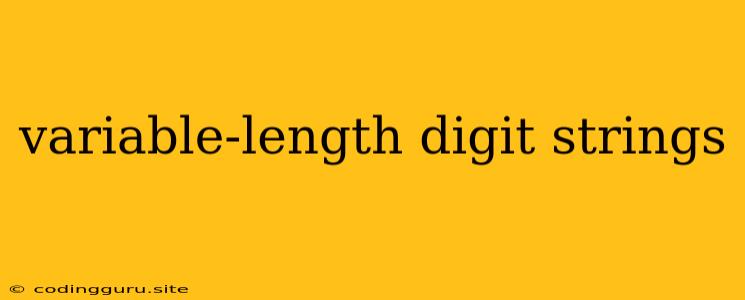Understanding Variable-Length Digit Strings: A Comprehensive Guide
Variable-length digit strings are a fundamental concept in computer science, particularly in programming and data processing. They represent sequences of digits that can vary in length, offering flexibility in representing numerical information. Understanding how to work with these strings is essential for tasks like:
- Storing and manipulating numerical data: Whether dealing with phone numbers, zip codes, or product identifiers, variable-length digit strings provide a convenient way to store and process such information.
- Data validation and formatting: Validating input to ensure it adheres to specific length requirements is crucial, especially when dealing with sensitive information.
- Data analysis and reporting: Extracting meaningful insights from numerical data often involves manipulating and analyzing variable-length digit strings.
Let's dive deeper into the world of variable-length digit strings and explore how they function in different programming contexts.
What are Variable-Length Digit Strings?
Imagine a scenario where you need to store the population of different cities. While some cities might have populations in the hundreds, others could have millions. A fixed-length data structure wouldn't be suitable because it would either waste space for smaller cities or truncate larger populations. This is where variable-length digit strings come in.
A variable-length digit string is a sequence of digits that can be of any length, depending on the value it represents. For instance:
- Phone numbers: The length of a phone number can vary depending on the country or region.
- Credit card numbers: Credit card numbers typically have a specific length, but variations exist across different card types.
- ZIP codes: ZIP codes in different countries can have different length requirements.
Representing Variable-Length Digit Strings in Programming
In programming, variable-length digit strings are commonly represented using data types like strings or arrays depending on the programming language. Here's a breakdown:
1. String Data Type:
Strings, a standard data type in most programming languages, are designed to store sequences of characters. We can use strings to represent variable-length digit strings. For instance, in Python:
phone_number = "1234567890"
zip_code = "10001"
2. Array Data Type:
Arrays are collections of elements that can be accessed using indices. We can use arrays to store individual digits of a variable-length digit string. Here's an example in JavaScript:
let credit_card_number = [4, 1, 1, 1, 2, 2, 2, 2, 3, 3, 3, 3, 4, 4, 4, 4];
Working with Variable-Length Digit Strings
The core operations when dealing with variable-length digit strings include:
1. Conversion:
- Converting between strings and numerical representations: You can use built-in functions in programming languages to convert strings to integers or vice versa.
- Converting between different numerical base representations: For instance, converting decimal numbers to binary or hexadecimal formats.
2. Validation:
- Checking for valid digit strings: Ensuring that the string consists only of digits and meets specific length requirements.
- Implementing checksum algorithms: Verifying the integrity of data by calculating a checksum based on the digits in the string.
3. Manipulation:
- Extracting specific digits: Accessing individual digits from the string using indexing or slicing.
- Performing arithmetic operations: Adding, subtracting, multiplying, or dividing values represented by digit strings.
Examples of Variable-Length Digit String Usage
Here are practical examples of how variable-length digit strings are utilized in real-world scenarios:
1. Database Systems:
- Storing phone numbers and addresses: Databases often use variable-length digit strings to represent phone numbers, zip codes, and other numerical data.
- Implementing data validation rules: Database systems enforce data validation rules to ensure that the length and format of digit strings meet specific requirements.
2. Financial Applications:
- Processing credit card transactions: Financial applications rely on variable-length digit strings to store and process credit card numbers, ensuring secure and reliable transactions.
- Calculating interest rates and loan repayments: Financial calculations often involve manipulating numerical values represented as variable-length digit strings.
3. Website Development:
- Handling user input forms: Web forms often require users to input numerical data, like phone numbers or postal codes. Website development frameworks use variable-length digit strings to process and validate this input.
- Generating unique identifiers: Website applications generate unique identifiers for users, products, or other entities, often using sequences of digits stored as variable-length digit strings.
Challenges with Variable-Length Digit Strings
While variable-length digit strings offer flexibility, they come with certain challenges:
- Memory Allocation: Dynamically allocating memory to store variable-length strings can lead to memory inefficiencies if not handled carefully.
- Data Validation: Enforcing specific length and format requirements can be more complex with variable-length digit strings.
- Performance: Operations on variable-length digit strings can sometimes be slower compared to fixed-length data structures.
Tips for Working with Variable-Length Digit Strings
Here are some best practices for working with variable-length digit strings:
- Choose the right data type: Select a data type that best suits your needs, considering the range and length of values you'll be storing.
- Implement validation rules: Enforce data validation rules to ensure that the strings meet specific requirements.
- Optimize for performance: If performance is a concern, explore optimized data structures or algorithms for manipulating variable-length digit strings.
- Avoid unnecessary conversions: Minimize the number of conversions between strings and numerical representations to improve efficiency.
Conclusion
Variable-length digit strings are essential for representing numerical data that can vary in length. Understanding their properties, data types, and manipulation techniques empowers developers to effectively store, process, and analyze numerical information in diverse applications. By addressing potential challenges and adhering to best practices, developers can leverage the power of variable-length digit strings while ensuring code efficiency and data integrity.
